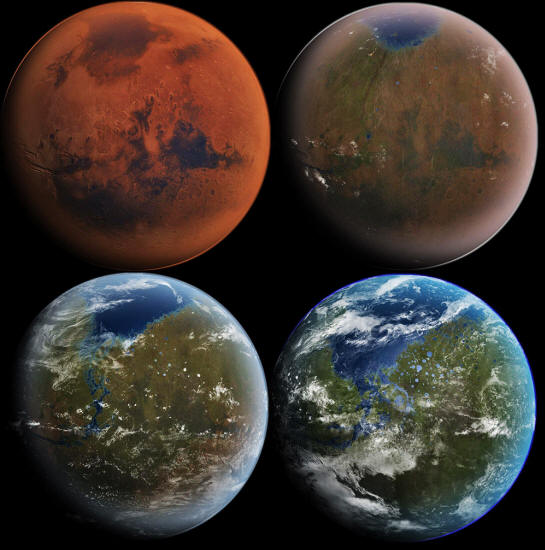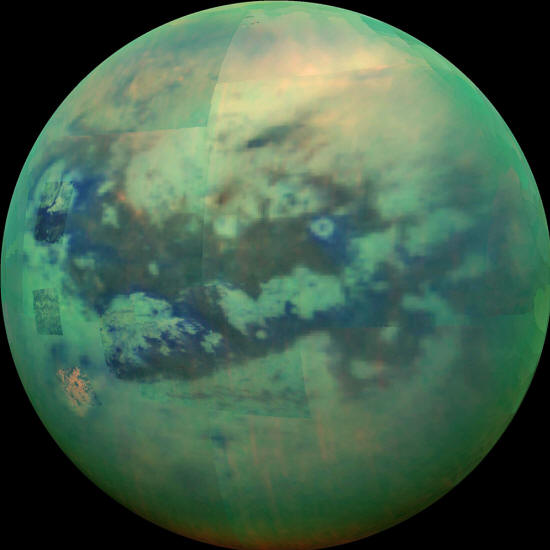|
from BigThink Website
When it comes time for humanity to pick a new home,
where will we
go...?
Whether that's out of humanity's sheer pioneering
spirit or the pragmatic survival instinct to spread out so that a
catastrophe on Earth doesn't wipe out the species, establishing a
colony on a nearby planet seems like a must.
No matter where we go in our solar system, we'll have to engage in one of the largest projects imaginable:
Depending on the environment we want to transform into a more Earth-like one, the nature of this project will vary tremendously.
Here's some examples from some of the most likely candidates for terraforming in our solar system.
An artist's depiction of Mars' gradual transformation
via terraforming.
It goes through similar
seasons to Earth, has a relatively similar atmospheric composition,
its day-night cycle is extremely close to our own, it possesses
abundant water in the form of ice, and it lies in the Sun's
habitable zone.
Proposals to create the right kind of atmosphere on Mars - like Elon Musk's flashy idea of nuking the polar ice caps to release stored CO2 and water vapor, thereby heating the planet up - won't work long term without a magnetosphere to protect the planet against solar wind.
With Mars' current,
flimsy atmosphere, between
1 and 2 kilograms of gas are lost to
space every second. Not to mention that the lack of this protective
magnetosphere also exposes the planet and all life on it to deadly
radiation from the sun.
This would be an incredible engineering task, likely requiring regular maintenance and fuel to keep the magnet powered. But it would be the first step to ensuring that Mars could be made habitable.
Even prior to that point, Mars gradual growth of an atmosphere would make future exploration on the red planet easier and easier.
An artist's depiction of
Venus if it were terraformed.
The surface temperature is 462°C, or 864°F; it has the opposite problem as Mars, with an atmosphere more than 90 times as dense as that of the Earth; and it's got no breathable oxygen.
Not to mention that it's covered in volcanoes and rains sulfuric acid.
On the other hand, it's
our closest planetary neighbor, and its gravity is about 90 percent
that of Earth's compared to Mars' 38 percent, meaning our muscles
and bones wouldn't atrophy while living there.
Venus's major problem is
its excess of CO2, which makes the surface of the planet
too hot for life and too heavy for humans.
This would need to be
supplement by a bombardment of those elements mined from asteroids
as well in order to remove enough carbon from the atmosphere for
human life.
Seeing as how our inability to do that on Earth may be one of the biggest reasons to find another planet, Venus may not be the ideal target for terraforming in the future.
An alternative to terraforming, however, would be to build a floating city in the Venusian clouds, a feat that isn't too far-fetched technologically.
as captured by NASA's Galileo
spacecraft/
(German Aerospace Center)
On Earth, we're exposed to about 0.066 rems of radiation per day.
Callisto, in contrast, is
exposed to about 0.01 rems per day, which humans can tolerate.
Of course, these planets would be completely covered in oceans hundreds of kilometers deep, and Callisto wouldn't have its own magnetosphere to keep that atmosphere in place long term, but their abundance of water makes it an attractive target nonetheless.
More concerning is the possibility that life already exists beneath the Galilean moons' icy surfaces, in the warm waters by thermal vents.
If we were to discover such life, would it be ethical to disrupt the only alien life we have ever known?
as seen by NASA's Cassini spacecraft. Because Titan's atmosphere is so hazy, viewing it in the wavelengths of visible light is not possible. Using the infrared spectrum enables us
to see
through the clouds to the moon's surface.
Its hydrocarbon reserves (such as petroleum) are several hundred times greater than all known reserves on Earth.
Together, these ingredients would be of significant benefit to any terraforming project.
If Titan's atmosphere does resemble early Earth's, then transitioning to an atmosphere that resembles modern Earth would be (relatively) straightforward.
One proposal would be to position mirrors in orbit to direct focused sunlight onto the moon's surface.
***
There are challenges common to all of these potential candidates for terraforming.
The big one, of course, is getting there. Many of these targets are incredibly distant.
Then, there's the issue of establishing a semi-permanent colony while the long work of terraforming goes on.
It's difficult to speculate about the capabilities we'll have at our disposal when terraforming a planet becomes a feasible project, but it could be hundreds, possibly thousands of years before any of these planets are completely terraformed.
And these are just some of the known issues:
Despite these major
challenges, the vast majority of humanity believes that establishing
a second home in our solar system is a necessity - the question is,
which will it be?
|






